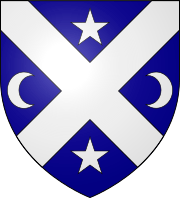Earl Haig
| Earldom Haig Chief of Clan Haig | |
|---|---|
  Arms: Azure a Saltire between two Mullets in chief and base, a Decrescent and Increscent in fess Argent. Crest: A Rock proper. Supporters: Dexter: a Bay Horse caparisoned, thereon mounted a Trooper of the 7th (Queen’s Own) Hussars, habited, armed and accoutred, all proper. Sinister: a Bay Horse caparisoned, thereon mounted a Lancer of the 17th (The Duke of Cambridge’s Own) Lancers, habited, armed and accoutred, all proper.[1] | |
| Creation date | 18 October 1919[2] |
| Monarch | George V |
| Peerage | Peerage of the United Kingdom |
| First holder | Sir Douglas Haig |
| Present holder | Alexander Haig, 3rd Earl Haig |
| Remainder to | 1st Earl's heirs male of the body lawfully begotten |
| Subsidiary titles |
Viscount Dawick Baron Haig |
| Status | Extant |
| Seat(s) | Bemersyde House |
| Armorial motto |
TYDE WHAT MAY (What will be, will be) |
Earl Haig is a title in the Peerage of the United Kingdom. It was created in 1919 for Field Marshal Sir Douglas Haig. During the First World War, he served as Commander of the British Expeditionary Force on the Western Front in France and Belgium (1915–18). Haig was made Viscount Dawick and Baron Haig, of Bemersyde in the County of Berwick, at the same time he was given the earldom, also in the Peerage of the United Kingdom[2] The viscountcy of Dawick is used as a courtesy title by the Earl's son and heir apparent. As of 2016 the titles are held by the first Earl's grandson, the third Earl, who succeeded his father in 2009.
The family seat is Bemersyde House, near Newtown St. Boswells, Roxburghshire.
The family motto is "Tyde what may", which refers to a 13th-century poem by Thomas the Rhymer which predicted that there would always be a Haig in Bemersyde:
'Tyde what may betyde
Haig shall be Haig of Bemersyde'.
Earls Haig (1919)
- Douglas Haig, 1st Earl Haig (1861–1928)
- George Alexander Eugene Douglas Haig, 2nd Earl Haig (1918–2009)
- Alexander Douglas Derrick Haig, 3rd Earl Haig (b. 1961)
There is currently no heir apparent to the Earldom, Viscountcy, or Barony. Should the 3rd Earl die without an heir, the titles will go extinct.
References
- ↑ Fox-Davies, Arthur Charles (1904). The Art of Heraldry: An Encyclopaedia of Armory. T.C. & E.C. Jack. p. 352. Retrieved 18 February 2016.
- 1 2 "No. 31610". The London Gazette. 21 October 1919. p. 12889.
- Kidd, Charles, Williamson, David (editors). Debrett's Peerage and Baronetage (1990 edition). New York: St Martin's Press, 1990.